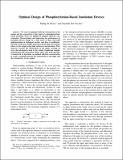Optimal design of phosphorylation-based insulation devices
Author(s)
Rivera, Phillip M.; Del Vecchio, Domitilla
DownloadDel Vecchio_Optimal design.pdf (503.7Kb)
OPEN_ACCESS_POLICY
Open Access Policy
Creative Commons Attribution-Noncommercial-Share Alike
Terms of use
Metadata
Show full item recordAbstract
We seek to minimize both the retroactivity to the output and the retroactivity to the input of a phosphorylation-based insulation device by finding an optimal substrate concentration. Characterizing and improving the performance of insulation devices brings us a step closer to their successful implementation in biological circuits, and thus to modularity. Previous works have mainly focused on attenuating retroactivity effects to the output using high substrate concentrations. This, however, worsens the retroactivity to the input, creating an error that propagates back to the output. Employing singular perturbation and contraction theory tools, this work provides a framework to determine an optimal substrate concentration to reach a tradeoff between the retroactivity to the input and the retroactivity to the output.
Date issued
2013-06Department
Massachusetts Institute of Technology. Department of Mechanical EngineeringJournal
Proceedings of the 2013 American Control Conference
Publisher
Institute of Electrical and Electronics Engineers (IEEE)
Citation
Rivera, Phillip M., and Domitilla Del Vecchio. “Optimal Design of Phosphorylation-Based Insulation Devices.” 2013 American Control Conference (June 2013).
Version: Author's final manuscript
ISBN
978-1-4799-0178-4
978-1-4799-0177-7
978-1-4799-0175-3
ISSN
0743-1619